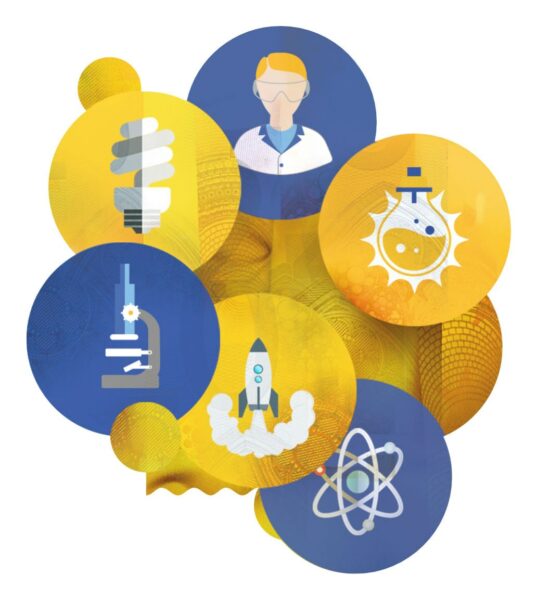
Chemistry and its industry have a strategical role in the EU economy, providing products to several other industrial segments. However, they are mostly perceived just as a source of human health and environmental damage1 as they traditionally rely on fossil resources and hazardous, polluting and/or energy-intensive processes. However, these issues can be solved, mainly by exploiting renewable bio-based materials, and by replacing current technologies and production processes with safer and more eco-friendly ones, reducing waste and pollution, and raising energy efficiency.
The adoption of more sustainable approaches will have a great socioeconomic impact, as innovation in the chemical sector is often a trigger of innovation in other sectors.
Particularly, the polymer segment has been under tremendous pressure for improving its greenness2 as the public opinion mostly associates it with plastics pollution, nearly forgetting that polymers are remarkably involved in comfort and facilitation of human life.
Photopolymers are an interesting family of polymers obtained by photoinduced processes that are more sustainable than thermal processes, as they need much lower energy, do not use solvents, are faster and more efficient3. Photoinduced polymerisation is a key enabling technology (KET) for the coating industry, printing inks, packaging, wood finishing, and electronics. The industrial segments listed cover just the tip of the iceberg when it comes to applications: products based on photopolymers are present in everyday life, e.g. contact lenses, filling for dental cavities, credit cards, chips, adhesives and composites4. These markets were globally valued at $3.5 billion in 2018 and are expected to grow at a 7.7% rate till 20235. New sectors can leverage photopolymerisation, e.g. growing industries like 3D printing and other end-user industries such as in the medical sector. Also small enterprises, which are the largest job creators and the most critical for the early stages of industrialization, can easily and advantageously uptake this technology, as the intrinsic features of photoinduced reactions and the simple setup of the plants help reducing waste, raising energy efficiency and improving production processes.
Although the photoinduced polymerisation technology is greener than most chemical processes, it still presents sustainability issues3, and low industrial uptake in advanced materials applications. The present project ESPERANTO (Enhancing the Sustainability of PhotopolymERs ANd phoToinduced prOcesses) aims at improving the sustainability of photoinduced polymerisation and boosting the use of this technology in the industrial sector, to replace less sustainable processes. It embraces the EU strategy supporting more sustainable and safer consumption and productions, transforming the way polymeric products are designed, produced, used and recycled and is in line with UN SDG 126. ESPERANTO converts chemical knowledge and ideas into prototypes demonstrating the readiness of the photopolymerisation technology for new applications to promote the industrial uptake7. ESPERANTO addresses sustainability not only by technological innovation, but also by training of a new generation of researchers. Commitment to sustainability is still a very niche priority, ranking high only in Government and Healthcare and rather low across all the other sectors7. This highlights the urgent need to educate around the relevance of this theme: ESPERANTO proposes a training programme focused on sustainability to form creative, entrepreneurial, innovative researchers, having environmental responsibility. The researchers will gain transferable competences to lead and manage the innovation in the field of photopolymerisation with a systematic approach to sustainability: this is also likely to enhance their career perspectives.
1Advanced Technologies for Industry – Sectoral Watch Technological trends in the chemical industry https://ati.ec.europa.eu/reports/sectoral-watch/technological-trends-chemical-industry accessed 28/10/21
2Plastics, the circular economy and Europe′s environment – A priority for action, EEA Report No 18/2020, European Environment Agency https://www.eea.europa.eu/highlights/plastics-environmental-concern accessed 31/10/21
3M. A. Tehfe, et al., Appl. Sci., 2013, 3, 490;
4J. V. Crivello and E. Reichmanis, Chem. Mater., 2014, 261, 533; N. Corrigan et al., Angew. Chem. Int. Ed., 2019, 58, 5170
5UV Curable Resins Market by Formulation, by Application, by End User, by Geography – Global Market Size, Share, Development, Growth, and Demand Forecast, 2013–2023, June 2018, P&S Market Research
6EU plastics strategy https://ec.europa.eu/environment/strategy/plastics-strategy_en accessed 28/10/21; UN Sustainable Development Goal 12: “Ensure sustainable consumption and production patterns” https://www.un.org/sustainabledevelopment/sustainable-consumption-production accessed 21/10/21